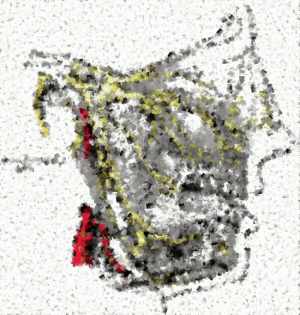Trigeminal Neuralgia Highlighted
I recently received a comment about an article I wrote in HeadWay about Trigeminal Neuralgia. When I went to check the article, I immediately found a typo, which helped to keep me humble. 🙂
 |
But I did want to highlight Trigeminal Neuralgia again here at the blog, and include some of the comments that were sent to me.
First, I want to share some of these comments from a reader, to remind us all of the pain of TN:
I have had trigeminal neuralgia for 32 years since age 30. I have undergone three microvascular decompressions, percutaneous radiofrequency rhizotomy, and an intraoral neurectomy, plus a brain and mouth wound infection, all 15 years ago. My TN pain is combined with intractable migraines! I want to thank you for the accuracy of the succinct article that was recently sent to me by a friend that you wrote about trigeminal neuralgia. I volunteer as a counselor for TNA (I am listed on their website). I find that TNers are very despondent, discouraged people, and rightly so. I hope I am able to share my knowledge and encouragement with them. One of the descriptions you may want to use in future articles about TN is “lancinating” pain. Personally, this is a very descriptive adjective for the type of spear-piercing, electric pain that is experienced from this disease. Thanks again for your outreach. Your article was such a great summation, I feel like making copies and handing them out on a street corner, for TN is a very misunderstood disease.
Check out the TNA (The Facial Pain Association) here. Here’s an excerpt from the article which you can read here (yes, I corrected the typo!):
Symptoms of Trigeminal Neuralgia
The attacks of trigeminal neuralgia are brief but incredibly painful. The pain is in the face and may last for a fraction of a second up to two minutes. Sometimes there can be several attacks in succession. The pain has been described as electric shock-like, burning, extreme, sharp, stabbing, intense, crushing. Though for some people the pain can be mild, for many it is the worst pain imaginable and can totally incapacitate the patient.
Usually TN pain is one-sided, commonly on the cheek or chin, often the teeth, gums, lips and jaw, and occasionally the eye or forehead. It can also cause muscle spasm on the side with the pain.
The pain of TN is often the same every time for each patient, and it’s often triggered by something. Typical triggers include talking, shaving, washing, brushing teeth, applying makeup, or being exposed to wind.
Though the pain may come in repeated attacks (over hours, days, weeks…), eventually (in some patients) there’s a time when there is no pain – in fact, pain cannot even be triggered.
In other patients, the pain continues as a dull background pain.
TN can happen to anyone, even children. However, it seems more common in women, especially women over 50. One you have it, it can get worse and change over time (for example, it may start as various episodes and progress into constant pain).
It’s important to get an expert diagnosis of TN, because it can frequently be misdiagnosed (for example, as MS, glossopharyngeal neuralgia, brainstem tumour, etc).
Another challenge is that TN can exist along with another disorder. For example, a cluster patient (cluster headache) may also have TN. Paroxysmal hemicrania is something else that has existed along with TN. In that case you need a proper diagnosis of both so you can have both treated.

14 December 2010 @ 7:54 am
I have been a victim of TN for around six years and my condition appears to be now getting progressively worse. Recently, I suffered from TN pain at the top end of the scale unabated for six hours. In entering the world of ‘emergency medical provision’ e.g. ambulance, paramedics, accident and emergency dept etc. it is now clear to me that there is a breathtaking ignorance of the condition. However, I have a certain amount of sympathy for the medics. Two doctors admitted to me that they vaguely remembered something about it from university.
In describing the symptoms of TN, I note the above article states ‘attacks of trigeminal neuralgia are brief’. This can only be considered a general and not definitive description of the symptoms and they may only apply to some. In fact this would have applied to my condition for the first year to 18 months. I have come to realise that TN pain is either at zero, ten, or even somewhere beyond ten, it is only the length of time the pain is present that differs. During my most recent episode, I spent two weeks in hospital during which I endured four days of the most horrific pain imaginable. Morphine only served to make the pain worse. I have no complaints regarding my treatment on the ward. The staff there eventually managed to kill the pain with a mixture of pethidine, gabapentin, carbemazepine, baclofen and amytrypteline (and a few other bits and pieces), or did it just settle down on its own as it has done in the past (thats my great fear).
Finally, I would emphasise that this is only my experience and may not apply to anyone else.